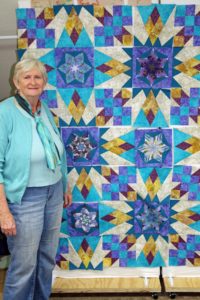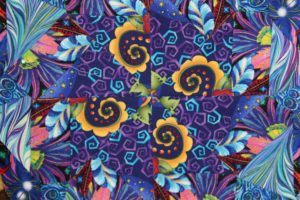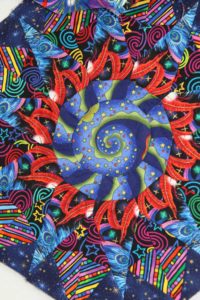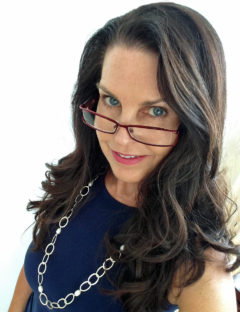![]() April 2011
April 2011
Story & Photography by Gail G. Collins
 When asked how she began quilting 20 years ago, Joan Scott laughs and says, “I took a class, and it took over my life.” Looking around her Cliff Rose studio, it is easy to understand how the patterns, textures and palettes could mesmerize a soul.
When asked how she began quilting 20 years ago, Joan Scott laughs and says, “I took a class, and it took over my life.” Looking around her Cliff Rose studio, it is easy to understand how the patterns, textures and palettes could mesmerize a soul.
They beckon with possibility. Spools of variegated, coiled thread shimmer with hues that capture a sunset, a river’s depths and floral fantasies. Quilt blocks tacked to a board in wheels of lavender and green harbor dragonflies and butterflies likening a summer meadow. Nearby, kaleidoscopic works spin and tease the eye in azure whimsy. And these are just the raw materials and latest works in progress. I laugh with Scott and sit down to let the quilting fever pass.
“I’m fascinated by color, and I’m a puzzler—I love putting patterns together,” Scott says before confessing, “I’m a junkie.” She points to a wall stacked with tubs of collected fabrics as evidence. She justifies her habit with a slew of projects in her studio and the Artists’ Gallery in Flagstaff where her textile art is often displayed. Most of Scott’s inspiration comes from her natural surroundings. “Look where I live!”
Scott moved to Flagstaff and began her fiber adventures as a weaver three decades ago. The lengthy process generally creates a material that requires further effort instead of an end product. After fiddling with pieced jackets, Scott was hooked on quilting.
 Traditional quilting involves three layers: an ornamental, pieced top; batting and backing. The layers are held fast with decorative stitches, known as quilting. Quilting can be done by hand or by machine. Scott uses a long arm sewing machine offering an enormous free space for maneuvering on blocked quilts. But there is no computerized design plate for her. Scott’s quilting is done freehand. “It takes practice, practice, practice,” she says as I admire the lovely, looping lines of a floral pattern traced over her angled piecework. Instinct and trial guide Scott’s unique concept for each quilt.
Traditional quilting involves three layers: an ornamental, pieced top; batting and backing. The layers are held fast with decorative stitches, known as quilting. Quilting can be done by hand or by machine. Scott uses a long arm sewing machine offering an enormous free space for maneuvering on blocked quilts. But there is no computerized design plate for her. Scott’s quilting is done freehand. “It takes practice, practice, practice,” she says as I admire the lovely, looping lines of a floral pattern traced over her angled piecework. Instinct and trial guide Scott’s unique concept for each quilt.
Quilting is an ancient art form. Exhumed pharaohs have been found  wrapped in batted cloth. Arabs used the layered fabric under chainmail, and Templar Knights wore quilted undergarments to prevent chaffing from their armor. The Chinese valued quilted material for warmth, and in the 16th Century, the first Dutch and English settlers brought the craft to America. Limited outposts to buy goods necessitated that pioneers wear clothes until they were worn out. Then, the items were relegated to the scrap bag for quilts. As resources became more plentiful, designs became more elaborate, and an art form was born in festivals and county fairs.
wrapped in batted cloth. Arabs used the layered fabric under chainmail, and Templar Knights wore quilted undergarments to prevent chaffing from their armor. The Chinese valued quilted material for warmth, and in the 16th Century, the first Dutch and English settlers brought the craft to America. Limited outposts to buy goods necessitated that pioneers wear clothes until they were worn out. Then, the items were relegated to the scrap bag for quilts. As resources became more plentiful, designs became more elaborate, and an art form was born in festivals and county fairs.
Further exploration of Scott’s studio leads to an Asian-inspired wall hanging in bold black, gold and red. She sighs fondly before turning to shake out the folds of a quilt called Feathered Fantasy that epitomizes spring. Sharp diagonals in verdant shades nestle among lilacs. The topstitching overlays a subtle softness in curved, flowing images. Next, Scott unrolls a piece called Carnivale, a riot of vivid flashes, reminiscent of confetti, streamers and pennants.
Scott claims no favorites when it comes to her quilts. “I fall for each one I create,” she admits. Her latest flirtation is with color gradation. An earthy palette of brown to ecru tones is braced with teal and will grace Scott’s own bed. “I believe in functional work,” she says. “Too much is made fast and cheap these days. I make beautiful things that can be used in daily life and reflect our culture.”
Like most artists, Scott values a range of expressions. She has been a belly dancer, a weaver, a painter and still dyes silk where pigments float like water on a gossamer canvas. She adjusts the scarf at her neck, and I notice it is a Scott original.
Creating is obviously a pleasurable process. The artist pages through a design book filled with samples. Like recipes to a chef, these are merely a starting point. “I play with patterns and colors on a computer software program,” Scott says. “Then, I grab my scrap bag and just start piecing things together.”
For stimulation, Scott attends festivals where ideas travel farther and faster than her grandmother’s legacy ever imagined. And there are also retreats where Scott immerses herself in the skills of pieced cloth and thread. “We stay up until 2 a.m., and then, begin again at seven in the morning.”
“You get addicted to the pattern possibilities and colors. I have so many quilts in my head. And still, I’m attracted to new fabrics, so another quilt pops into my head. I don’t think I’ll ever stop because of it,” says Scott with a giggle. NAMLM
See more of Joan Scott’s art at www. cliffrosestudio.com
